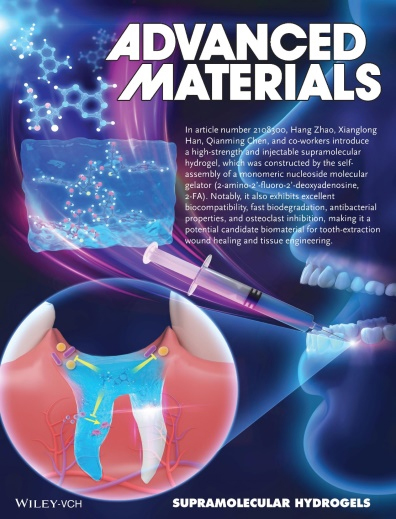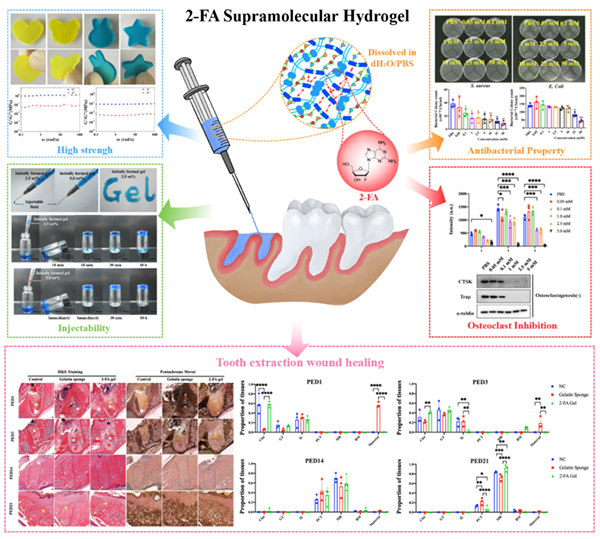WCSS Researchers Fabricated a High-strength and Injectable Supramolecular Hydrogel for Tooth-extraction Wound Healing.

Frontispiece: High-Strength and Injectable Supramolecular Hydrogel Self-Assembled by Monomeric Nucleoside for Tooth-Extraction Wound Healing
A team of researchers from West China School of Stomatology (WCSS), Sichuan University successfully fabricated a high-strength and injectable supramolecular hydrogel by constructing a multi-hydrogen-bonding system, which was self-assembled by a monomeric nucleoside molecular gelator, 2-amino-2′-fluoro-2′-deoxyadenosine (2-FA).
Their research <https://doi.org/10.1002/adma.202108300> was published and selected as a frontispiece in the journal Advanced Materials (Volume 34, Issue 13).

Multifunctional 2-FA supramolecular hydrogel employed for tooth extraction wound healing
Hydrogels with high mechanical strength and injectability have attracted extensive attention in biomedical and tissue engineering. However, endowing a hydrogel with both properties is challenging because they are generally inversely related.
By constructing a multi-hydrogen-bonding system, researchers fabricated a high-strength (storage modulus reaches 1 MPa at a concentration of 5.0 wt%) and injectable (sol–gel transition within seconds at 37 °C) supramolecular hydrogel. It is constructed by the self-assembly of a monomeric nucleoside molecular gelator (2-FA). Researchers also confirmed that the multi-hydrogen-bonding system is essentially based on the synergistic interactions between the double NH2 groups, water molecules, and 2′-F atoms.
Interestingly, researchers noticed that 2-FA hydrogel also exhibits excellent biocompatibility and antibacterial activity. When applied to rat molar extraction sockets, compared to natural healing and the commercial hemorrhage agent gelatin sponge, the 2-FA hydrogel exhibits faster degradation and induces less osteoclastic activity and inflammatory infiltration, resulting in more complete bone healing.
In summary, this study provides ideas for proposing a multifunctional, high-strength, and injectable supramolecular hydrogel for various biomedical engineering applications.
The study’s authors, from State Key Laboratory of Oral Diseases, are Zheng Wang, Yanan Zhang, Yijia Yin, Jiang Liu, Peiran Li, Yuxi Zhao, Ding Bai, Hang Zhao, Xianglong Han, Qianming Chen.
For more details, please click the link below.
https://doi.org/10.1002/adma.202108300